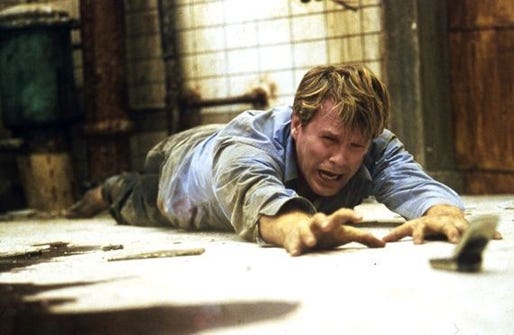Saw: 10th-Anniversary Re-Release

Two confused strangers wake up shackled to exposed pipes in a dark and dingy bathroom. On the floor between them, another man holding the gun he’s used to kill himself in one hand and a tape recording in the other.
It’s not a sick joke you’ve heard before, just the way “Saw” — before it became a franchise of futility — started out as not much like any other shocking serial killer thriller you’ve seen before. But if you’re looking for purposeful scares this weekend, you’ll have to settle with something you’ve seen before with this 10-year re-release.
At the time of its release, “Se7en” had become the genre’s decrepit, but dynamic, scripture. At least “Saw” found a pulpy, compelling variation on that film’s idea. Much like that film’s John Doe, the Jigsaw killer targets the dregs of society and those with sinful secrets. But rather than the aftermath of violence, nearly all of “Saw” is told from those victims’ perspectives as they’re targeted, making it a sadistic little corker in the early goings. It proved a hell of a calling card, too, for director James Wan, who went on to create more franchises in “Insidious” and “The Conjuring,” and dabble in such existing ones as the upcoming “Furious 7.”
But as gory a guilty pleasure as “Saw” was at its outset, it fell prey to the postulate that no one knows how to end a thriller without resorting to a surprise devoid of sense. A narrative blind-side hit, “Saw’s” final gotcha got ya in the moment, but thinking about it for even 10 seconds ruined the thrill. (Who can hold their breath that long or find a so perfectly timed sedative?) It should have been a sign for six (!) subsequent sequels with risible ret-con tactics that felt like a 40-car freeway pileup.
Sadly, the initial “Saw” got bad long before its ending, and aggressively so, resorting to the other, more traditional thriller traps of clichés and overacting.
Hadn’t Monica Potter learned that the time for intimate confessionals about marital problems is not when you’ve got a murderous nutjob at gunpoint? Wouldn’t Cary Elwes’ good doctor have considered the possible problems of parking in a garage with all the lighting of a subway tunnel? This came before Elwes, as one of the two aforementioned strangers, confused a psychological meltdown for wailing in the gruesome final moments.
Elwes at least has believable moments early in the movie, as his Dr. Lawrence Gordon fights against confusion and time to figure out just why he’s ended up captive in a room with young, outspoken Adam (Leigh Whannell, also the screenwriter).
Gordon learns that if he doesn’t kill Adam by a certain time, his wife (Potter) and daughter will be killed. Formerly suspected as the Jigsaw killer, Gordon puts together that this is the work of the man himself — infamous for placing people in physically or morally complex traps in which the victims sometimes have to kill or be killed. But Gordon knows nothing of the mental games Jigsaw is playing with Adam, a traumatized rogue cop on the case (Danny Glover) and pretty much every other character in the film.
There’s plenty of fine suspense and red-herring trickery sprinkled through the first hour. And Wan delved into the disturbing schemes of Jigsaw’s brutally intricate traps without turning us off to where the film is going. (The flashback scene to Glover’s near-death, and near-apprehension, experience with Jigsaw offered the best example of both.)
And while the conclusion whipped up a fair amount of dread that the bad guy would win, its big reveal generated more laughter than armrest-gripping tension. It looks comparatively classic, though, next to its stinky sequels.
Of them, only “Saw II” is worthwhile and, dare I say, better than the original. It’s out more to dropkick your mind than provoke thought, but it is a gruesome morality play with talk of absolution amid its crushed heads, blown-out brains and coughed-up innards. Plus, it largely dispenses with red herrings to focus on the human capacity for violence and mercy. After that, though, it was all rewritten narratives to let you know that some dude in an alley to whom you never paid attention three movies ago was behind the carnage all along.
Like too many thrillers of its time, “Saw” ended up being a sick joke on us. But it’s far preferable to most of the shameless, senseless sequels to follow and, eventually, foul up the franchise.


